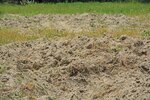

In Barnwell, Allendale and the rest of the southeast United States, feral pigs have become an existential threat to the sustainability of the region’s farmers. However, the conclusions of a new study conducted by the University of Georgia’s Savannah River Ecology Laboratory and the Warnell School of Forestry and Natural Resources provides hope for a dire situation.
Since the 1980’s, feral pig populations have exploded in the southeast, the root cause of which has been attributed to the invasive species introductions from European colonialism and the concurrent human-caused decline of natural predators like wolves and bears. As a result of their high fertility rates, intelligence, adaptability and persistent feeding habits, attempts at controlling or reducing wild pig populations in South Carolina and across the country have largely failed. Damage caused by wild pigs comes at a tremendous cost to farmers, as previously reported by The People-Sentinel.
However, the new study shows that controlling wild pig populations and the rooting damage that they cause is possible. Across three years and 19 privately owned agricultural properties in Hampton, Jasper and Newbury counties, scientists tracked, trapped and hunted feral pigs and were able to reduce environmental rooting by 99 percent.
“I was actually really surprised that it was that strong of a reduction in [pig] damage,” said James Beasley, professor of wildlife ecology and management at University of Georgia, who worked on the study. “This study was replicated across 19 properties, so this is a pretty reliable result that we’re confident in,” Beasley said. “Removing that constant presence of pigs on the landscape had a massive reduction in the rooting damage.”
The research was one of many feral hog management studies done by the United States Department of Agriculture (USDA) through funding from the Farm Bill, a major piece of federal legislation that shapes the country’s agriculture and nutrition systems.
Researchers began by assessing the amount of pigs in the region by baiting remote camera traps with corn throughout each property and tracking the number of pigs. Then, researchers used a variety of different USDA traps — corral traps, drop traps and net traps — to capture and euthanize the pigs. During the research, the USDA removed thousands of pigs and within 12–24 months, the abundance of pigs fell by around 70 percent.
One of the project’s strategies was to break up social groups of pigs to prevent them from coming onto an area of land. These social groups are called sounders, according to John Mayer, a wild pig research scientist at Clemson University. Sounders are collective groups of female pigs — often called sows — and their litters.
“These family groups are pretty much territorial,” Mayer said. “They’ve staked out their home range, and it may not be completely exclusive but the vast majority is. The thought is that if you go in and identify that sounder and remove them … you basically create a void. Then you go to the sounder next door and do the same thing there.”
Although its conclusions are hopeful, the study states that implementing a large-scale wild pig control program like that used in the study would require extensive resources.
“Further studies are needed to determine the long-term efficacy and costs associated with sustained wild pig control programs,” the study recommended. “Investments in wild pig control programs can be effective in reducing economic and environmental impacts of wild pigs and should be associated with monitoring programs to inform adaptive approaches to maximize the efficacy of management investments.”
Currently, the USDA is strategizing the best way to spend its money allocated for wild pig control, said Kurt Vercauteren, a research wildlife biologist at the USDA’s Animal and Plant Health Inspection Service.
“Doing studies like this helps us ask, ‘Okay, if we invest this much money, this much effort into removing pigs in this area, we can expect to reduce pig damages by this amount,’” said Vercauteren.
To scale up the operations used in the study to a level that could address the issue long-term would require more money and more resources, according to Vercauteren.
“That money would have to come through Congress or cooperating agencies or entities in order for wildlife services to increase the amount of feral swine control being done,” said Vercauteren. “All the money that comes into us for wild pig research and management goes out. We use it all. A major goal of research is to help figure out our best on the ground management strategies.”
Mayer said another issue preventing a solution to the problem is that hunters who want wild pig populations to kill are often near farms where pigs cause major damages.
“You still have a lot of people that like to hunt wild pigs and want wild pigs on the landscape,” Mayer said. “Typically, these [hunters] are not the producers that are losing money. They're also not [the] landowners that are seeing damage from these animals. … Farmers are typically trying to eke by financially as it is. They just don’t have the capital to go ahead and hire wildlife services on a large scale.”